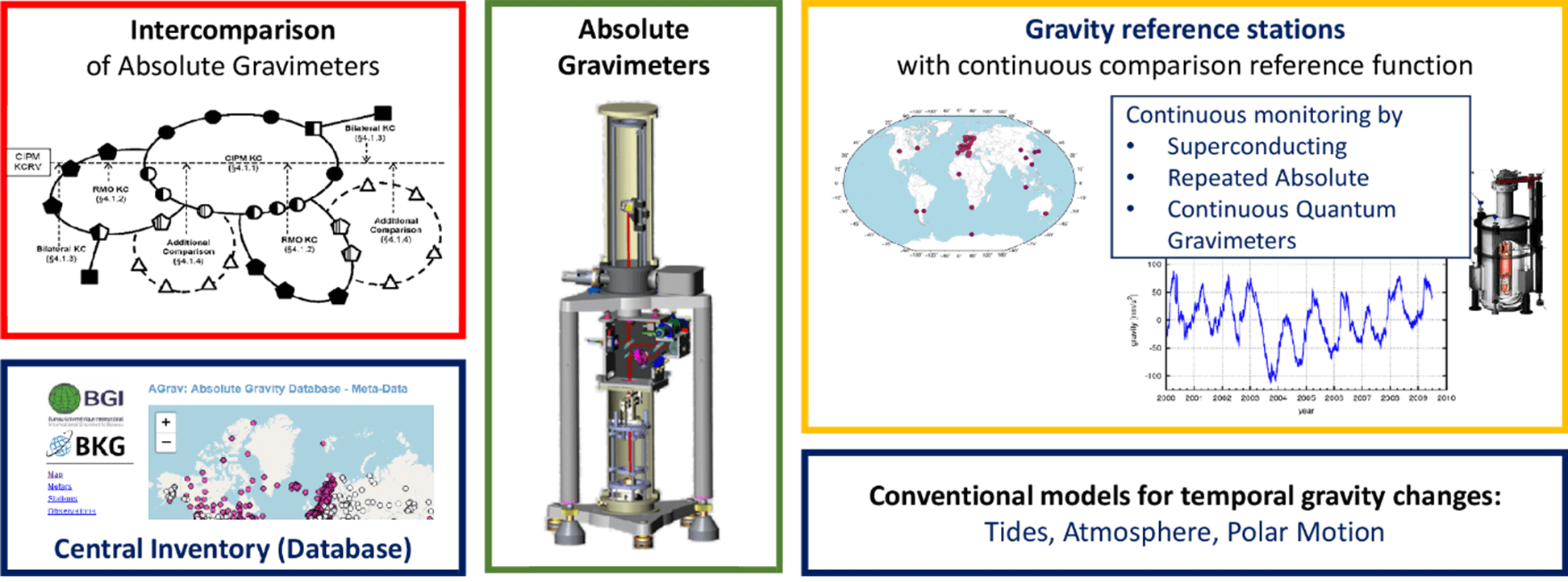Gravity
Reference Frame
How to refer gravity measurements at the Earth surface to a uniform reference?
So far, the valid gravity reference system of the IAG is still the International Gravity Standardization Net 1971 (IGSN71) (Morelli et al. 1974). Although it is widely used, at an uncertainty level of ![]() it fulfils neither the requirements nor the accuracy for the understanding of the Earth’s System and applications in metrology.
it fulfils neither the requirements nor the accuracy for the understanding of the Earth’s System and applications in metrology.
Following IAG Resolution No. 2 “Establishment of a Global Absolute Gravity Reference System” adopted at the XXVI, General Assembly of the International Union of Geodesy and Geophysics (IUGG) in Prague 2015, the IAG Joint Working Group 2.1.1 “Establishment of a global absolute gravity reference system” has developed the basis of a new system and frame to achieve accurate, homogeneous, long-term global recording of Earth’s gravity, while taking advantage of the potential of today’s absolute gravity measurements. (Wilmes et al. 2016, Wziontek et al. 2021)
The International Gravity Reference System (IGRS) is defined by the instantaneous acceleration of free-fall, expressed in the International System of Units (SI). It is completed by a set of conventional models for the time-dependent corrections of this quantity comprising constant components which define the conventional quantity “acceleration of gravity”.
The International Gravity Reference Frame (IGRF) as the realization of the IGRS is represented by absolute gravity measurements traceable to the SI that contain conventional temporal gravity corrections (Fig. 1). Due to its principle, absolute gravity observations at individual stations are not linked to each other avoiding the need to build up classical observation networks. All absolute gravimeters (AG) have to be checked at comparisons, where the gravity reference is realized based on a set of measurements by a group of AGs and the functional model for their processing. The comparisons follow the “CCM – IAG Strategy for Metrology in Absolute Gravimetry”, which also describes the traceability chain in gravimetry. The reliability of all AGs used for the realization of the IGRF has to be ensured further by regular monitoring at reference stations.
The IGRS Conventions 2020 (Wziontek et al. 2021) update the Processing Standards for the International Absolute Gravity Basestation Network (IAGBN) (Boedecker 1988) which are already applied for decades. Minor updates reflect the current state of the art but provide the compatibility with existing processing results.
The IGRF contains a global set of stations where reliable absolute gravity values with an accuracy of ![]() and better are provided to the users. The main infrastructure of the IGRF is formed by gravity stations of three different types:
and better are provided to the users. The main infrastructure of the IGRF is formed by gravity stations of three different types:
- Reference stations, which are providing an empirical gravity reference function as time series based on absolute monitoring of the gravity field derived from continuous recording by superconducting gravimeter (SG) in combination with repeated absolute gravity observations or from a continuously operated absolute quantum gravimeter. At minimum, repeated absolute gravity observations to capture annual variations are recommended.
- Comparison stations, which are reference stations with extended facilities to check the compatibility of instruments.
- Core stations, which are providing the link to main space geodetic techniques (GNSS, SLR; VLBI), preferably collocated with GGOS core stations.
All measurements at these stations should be documented and archived in the IAG absolute gravity database (AGrav) operated by BGI (Bureau Gravimétrique International) and IGETS (International Geodynamics and Earth Tide Service) for static and time variable measurements, respectively. Both IAG Services BGI and IGETS are also services within the IGFS (International Gravity Field Service).
To make the IGRF accessible to users and to finally replace the previous IGSN71 network, an adequate infrastructure based on absolute gravity measurements needs to be built up. This requires the support of international and national institutions, agencies and governmental bodies in charge of geodetic infrastructure which are encouraged to establish compatible first order gravity networks and to provide information about existing absolute gravity observations. This was acknowledged by IAG with Resolution No. 4 of 2019 and provides the frame for activities IAG Joint Working Group 2.1.1. to establish the IGRF.



